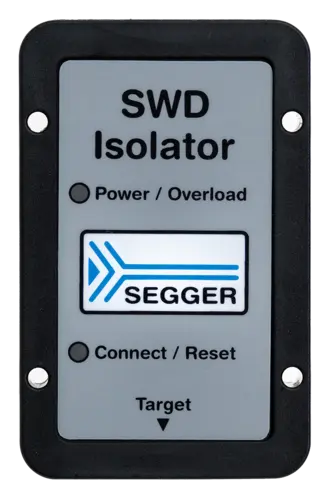Overview
The SWD Isolator can be connected between J-Link or Flasher and any Arm board that uses the standard 20-pin 0.1" male connector to provide electrical isolation. This is essential when the development tools are not connected to the same ground as the application. It is also useful to protect the development tools from electrical spikes that often occur in some applications, such as motor control applications. Another typical field of application is the development of products with sensors or other analog circuitry, in which case the target hardware is protected from electrical noise originating from the development PC.
Key features
- 1.2 V to 5 V target operation supported
- Powered from emulator side
- Overvoltage and overcurrent protection on emulator side
Additional features
- Basic isolation (1 kV DC)
- Overvoltage protection on VTref pin of target connector
- Standard 20-pin 0.1" male (target side) and male (emulator side) connector supporting SWCLK, SWDIO, SWO, RESET signals
- Power consumption on target side: <25 µA
- SWD frequency: Up to 4 MHz
- 4 LEDs to indicate emulator power, emulator overload, target power, and target RESET
- Housing
- ESD protection
Connectors and indicators
The SWD Isolator uses high speed digital isolators that allow a very low propagation time between input and output. It comes with the following connectors and indicators:
- 20-pin 0.1" male EMULATOR connector
- 20-pin 0.1" male TARGET connector
- Dual color LED (EMULATOR side): Green indicating power, red indicating power overload
- Dual color LED (TARGET side): Green indicating power, red indicating reset active
Target connector
The following table shows the target side pinout of the SWD Isolator:
| Pin | Signal | Type | Description |
|---|---|---|---|
| 1 | VCC | Input | The target side of the isolator draws power over this pin. |
| 2 | NC | NC | This pin is not connected on the target side of the isolator. |
| 3 | NC | NC | This pin is not connected on the target side of the isolator. |
| 5 | NC | NC | This pin is not connected on the target side of the isolator. |
| 7 | SWDIO | I/O | Bi-directional data pin of SWD. This pin should be pulled high on the target. Typically connected to SWDIO on target CPU. |
| 9 | SWCLK | Output | SWD clock signal to target CPU. It is recommended that this pin is pulled to a defined state on the target board. Typically connected to SWCLK on target CPU. |
| 11 | NC | NC | This pin is not connected on the target side of the isolator. |
| 13 | SWO | Input | SWD data output from target CPU. Typically connected to SWO on target CPU. |
| 15 | RESET | I/O | Target CPU reset signal. Typically connected to the RESET pin of the target CPU, which is typically called "nRST", "nRESET" or "RESET". |
| 17 | NC | NC | This pin is not connected on the target side of the isolator. |
| 19 | NC | NC | This pin is not connected on the target side of the isolator. |
Pins 4, 6, 8, 10, 12, 14, 16, 18, 20 are GND pins connected to GND.
Power supply
Both sides, target and emulator, are totally isolated from each other. The emulator side draws power from pin 19. The target side is powered from the emulator via an isolated DC/DC converter.
Preparing J-Link to supply power
J-Link needs to supply 5V power to the emulator side of the isolator on pin 19. In order to do this, you may have to configure J-Link once as follows:
- Make sure that SEGGER J-Link software is installed on your machine. It can be downloaded from here.
- Start J-Link Commander, which can be found under “Start -> Programs -> SEGGER -> J-Link”.
- Enter the following command to enable power supply via J-Link: power on perm.
- Plug in the isolator: The green LED on the emulator side should now be lit.
How to use the SWD Isolator with J-Link
In order to use the Isolator, follow these steps:
- Connect the SWD Isolator with the J-Link.
- Power J-Link.
- Make sure the green LED on the emulator side is lit. If this is not the case, please enter the command "Power on" in J-Link Commander. Please note that the target device cannot be powered through the isolator.
- Connect the target to the target side of the SWD Isolator.
- If the target is powered, the green LED on the target side should be lit.
The red LED on the target side is lit when a Target RESET is active (low).
How to use the SWD Isolator with another Arm emulator
The SWD Isolator has been designed for J-Link, but can also be used with other Arm emulators with the same pin-out. In this case, you should make sure that 5 V are supplied to pin 19 of the emulator connector and that your emulator is not damaged when applying 5 V to this pin. Do this at your own risk!
Safety
This isolator provides basic isolation only. Do not use with hazardous voltages without further protection measures to avoid risk of electrical shock and fire.
SEGGER isolators provide a basic isolation to withstand high voltages as mentioned in the resp. technical data section. To preserve integrity of human beings when dealing with potential hazardous voltages it is mandatory to have a second protection measure in place in case the first insulation barrier fails. This is called double or reinforced isolation. How this double isolation can be achieved depends on the use case or application setup. Also check your local safety related directives valid for your country to make sure all requirements are met.


